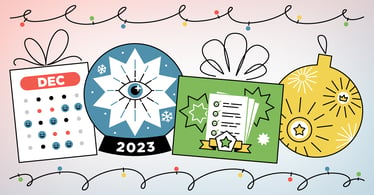Employee Development Plans Explained
As a leader, it’s both a responsibility and a privilege to impact the lives of your employees. As you move up in the ranks in your professional career, you gain a unique opportunity to help those grow alongside you.
The bonus is when you help these team members grow so much that you create a beautiful ecosystem where everyone is constantly learning, contributing, and growing into the best versions of themselves, including you as the leader.
So, what’s the most effective way to do that? It’s one thing to have monthly 1:1s and an open-door policy. But workers these days want a path, something they can work toward and feel proud of their accomplishments.
According to The University of Phoenix's Annual Career Optimism Index 2022, “49 percent of employees want to develop their skills but don't know where to begin.”
Leaders need to create a space and facilitate that growth. There’s no place for gatekeeping skills and remaining in silos — if someone is willing to put in the effort, a development plan may be exactly what’s needed to track improvement and exceeded performance.
What Exactly Is A Development Plan?
Think of a development plan, in its most simple terms, as a map from point A to point B. There will be challenges on the way, situations to navigate, and new experiences — but a development plan is a guiding light to an end goal.
A thoughtfully created employee development plan identifies career goals, current knowledge, and skills while outlining objectives and timelines to make that progress possible. It’s important for leaders to remember that this is about the employee first and foremost.
But, since creating this plan should be a collaborative effort between yourself and your employee, it also helps support the organization by offloading tasks to help them improve and encouraging team members to take on new initiatives to help the organization reach its overarching goals.
Where Does A Leader Begin?
So, we just said that a development plan is about the employee first — so when we say to start with organizational needs, it may seem a little confusing.
But, it’s critical that you get yourself and department in order so that you can present clear goals and KPIs to your employees when you discuss what their goals are and how to align them.
You can start by listing out what the department’s goals are. These should be based on an overall organizational goal or strategy, and the department leader ideally understands how their team will contribute to that.
Once these goals are determined, you can start organizing. Once the picture is clear, you can start breaking it down by project for the team and how things can be completed.
Then, it’s time to prioritize the work. Don’t feel like you need to do this in a silo! Feel free to bring in someone else to help sort your thoughts and bounce ideas off of — think of the most senior person on your team or maybe an outside party you have a good working relationship with.
Collaborating with Your Employee
Once you’ve organized your plans for the department, it’s time to meet with your team members and discuss their career goals and areas of improvement, how they align with the organization, and, most importantly, mutually agreed KPIs and timelines.
You can start with a generic question of where they see themselves in a year or more, but it helps if you frame it as what they would like to be doing. Younger employees, especially Gen Z, aren’t totally sure about the possibilities and opportunities available to them yet.
Use guiding questions like:
-
What energizes you in your current role?
-
What tasks would you like to focus on?
-
What tasks do you find difficult or draining?
- Are there any particular skills you’re interested in developing?
It’s key to be transparent and on the same page for areas of improvement, so don’t be afraid to have candid conversations about where they can improve.
Next, it’s time for you to use the information your employee gave you and discuss how their desired growth aligns with the organization's needs.
Since you’ve done organizing beforehand, you’ll be able to speak to what you think they excel at and share the projects and deliverables that they could grow in.
This is the perfect time to discuss the timelines and the key performance indicators. You can set high-level milestones like “deliver a full omnichannel campaign with limited supervision” and then work together to break down what exactly would go into that, such as emails, social posts, webinars, etc, and how long it would take to accomplish it.
Create The Plan And Implement It
Once you and your employees have created an agreed-upon development plan, don’t forget to follow up after the meeting with an email outlining the important parts of the meeting.
Then, it’s time to communicate the plan and create a routine of check-ins. I like to set up recurring meetings, separate from monthly 1:1s, that are very specific to a particular milestone or project progress.
My favorite way to stay organized is by using a project management tool with action items that can be checked off as progress is made. This helps you both keep track of progress, and holds you accountable to check in on your employee’s progress and put their development into your list of priorities.
After some time with this development plan in motion, evaluate the progress made and adjust if needed.
It’s entirely possible that after working on a certain project, your employee decides they like a certain aspect more and wants to lean into that. Be sure to communicate that deliverables still need to be met, but adjust milestones and goals so that they feel valued and heard.
Alternatively, if they are enjoying the work but running into trouble completing it, you can help diagnose this issue early and identify what roadblocks need to be removed so they can reach their goals.
How To Facilitate Long-Term Success
Employee development plans are critical to the growth of an organization and also give you an excellent opportunity to connect with your team members meaningfully.
Your employees are learning and growing, and you’re doing the same by expanding your leadership skills and reinforcing your own skills in your industry.
It’s important to remember to be understanding and supportive. Not everyone’s workstyles are the same and getting to know each of your employees' communication styles can positively impact the success of their career.
As a premier assessment provider with an extensive network of certified experts, we’d love to connect you with someone who can help you achieve your goals. Get the information you need to move forward here.
Topics:
Emotional Intelligence Team Management Business Strategies Workplace Culture Talent Management Behaviors
Jessica Boyle
Jessica is the Director of Marketing at TTI Success Insights. She creates marketing strategies that ensure both the business and its clients are efficient, profitable, and successful. Jessica is a graduate of Walter Cronkite School of Journalism and Mass Communication with a specialization in print and when she's not at work she's likely getting sunburned in her garden or watching Friends.


/How%20Employee%20Experience%20Leads%20to%20a%20Highly%20Productive%20Workforce.png?width=374&name=How%20Employee%20Experience%20Leads%20to%20a%20Highly%20Productive%20Workforce.png)

/Uncovering%20New%20Paths%20to%20Innovation_%20The%20Medici%20Effect.png?width=374&name=Uncovering%20New%20Paths%20to%20Innovation_%20The%20Medici%20Effect.png)
0 Comments